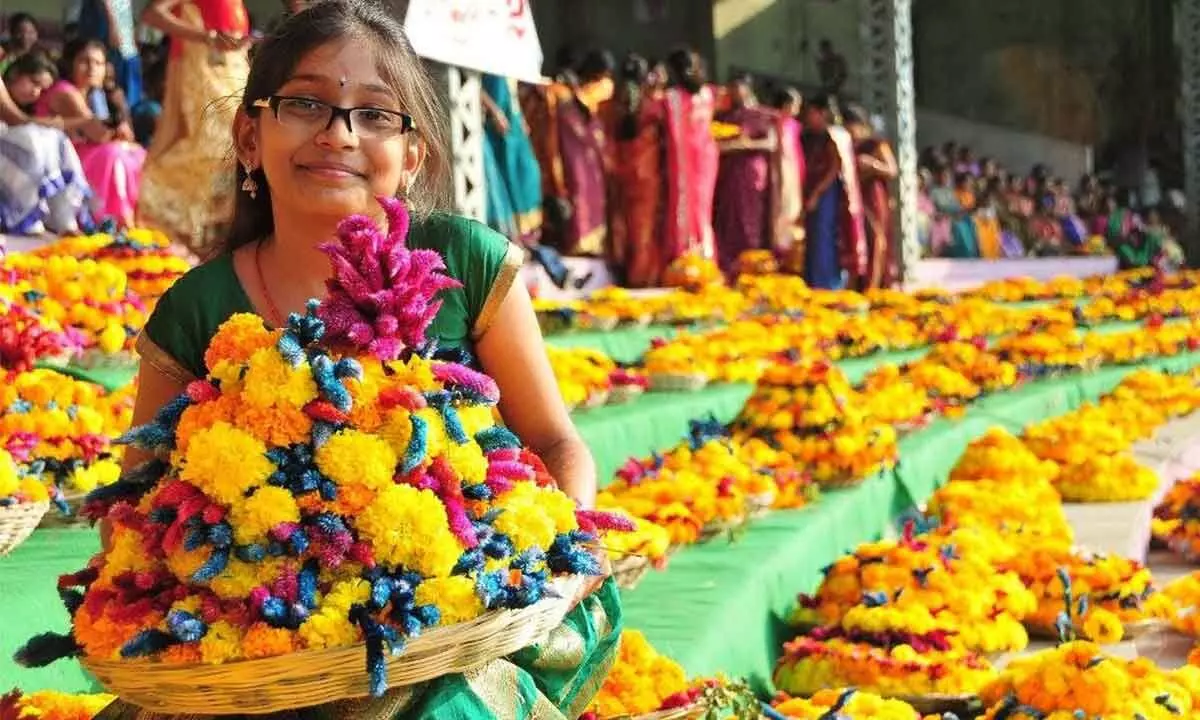A Bunch of Medicinal Goodness

It is an undeniable fact that with the swift passage of time, Bathukamma has emerged as the colourful, vibrant floral festival of Telangana. The conical-shaped arrangement made with myriad flowers, provides much-needed relief to the jaded eyes. The captivating colours of flowers like gunugu and tangedu dotted with banti, chamanti, nandi-vardhanam flowers elevate one’s aesthetic senses. The wild flowers that bloom during this time find way into homes across the State as womenfolk get cracking on dishing out Bathukammas of various sizes every evening till the grand finale arrives two days before Dasara. While this is so, many are oblivious of the beneficial aspects of the Bathukamma flowers, which are said to have rich medicinal values and curative powers for healing a variety of ailments. Akhil Kumar of Hans India speaks to Dr K Sudheer Kumar, a professor in Pharmacognosy, and takes a deep journey into world of Bathukamma flowers and reels out the umpteen health benefits of flowers that promote wellness
Bathukamma, like many other festivals, has a scientific dimension to it. It holds significance in terms of the potential medicinal qualities of the flowers and herbs used during the celebrations. This unique festival allows people to commemorate the healing, transformative, and revitalizing power of nature
♦ Gunugu or Celosia argentea: Possesses a range of medicinal properties, including antibacterial, anti-inflammatory, anti-diabetic, and antioxidant qualities, the leaves can be bruised and applied as a poultice to aid in the treatment of infected sores, facilitating wound healing
♦ Chandrakantha Rudraksha Puvvu or Mirabilis jalapa: used to treat wounds, dropsy, abscesses. It also reduces inflammation and is used in wound healing. Used ourgative, diuretic and for wound healing purposes. The leaf juice is used to treat wounds
♦ Thangedu or Cassia auriculata: The treatment of fevers, diabetes, ailments associated with the urinary system, and constipation. To address eye-related issues, alleviate symptoms of rheumatism, gonorrhea, and gout. It serves as a prominent blood purifier and laxative, aiding in the relief of constipation
♦ Banthi or Calendula officinalis: Antiseptic herb, exhibits fungicidal or mycotic toxin properties, particularly within the resins. To treat wounds, conjunctivitis, cuts, bruises, burns, athlete’s foot, acne, yeast infections, bee stings, and diaper rashes
♦ Chamanthi Puvvu or Chrysanthemum: Helps in preventing a number of diseases, treat chest pain (angina), high blood pressure, type 2 diabetes, fever, cold, headache, dizziness, and swelling, contains essential minerals like iron, sodium, phosphorus, zinc and copper
♦ Thamarra Puvvu or Nelumbo nucifera: Contains phosphorus, iron and vitamins B and C, to address various health issues, including diarrhea, blood sugar regulation, cholesterol management, inflammation, nutrition, acne prevention, menstrual cycle regulation, cough relief, cancer treatment, fever reduction, and the management of sweating
♦ Katla Puvvu or Jacquemontia pentanthos: Known for their rich content of medicinal and psychoactive alkaloids. A valuable medicinal plant with anti-cancer, anti-diabetic, and anti-inflammatory properties
♦ Beera Puvvu or Luffa aegyptiaca: Treats cold, nasal swelling, sinus issues, muscle and chest pains, and supporting skin detoxification. Addresses arthritis pain, restoring menstrual regularity, and promoting milk flow in nursing mothers
♦ Budide-gummadi or Cucurbita pepo: Used as an anti inflammatory, antiviral, analgesic urinary disorders, anti-ulcer, antidiabetic and antioxidant traditional medicine, particularly Ayurvedic systems

















